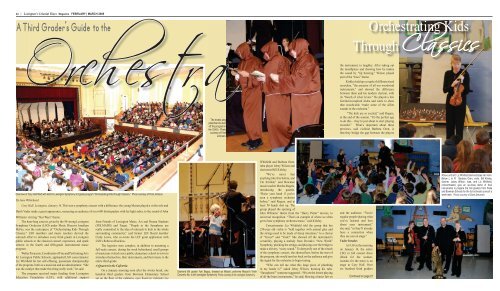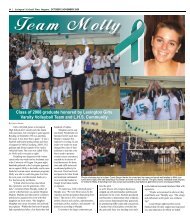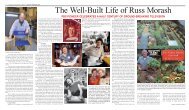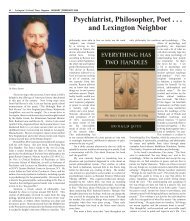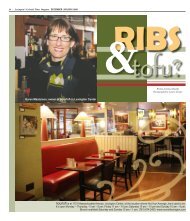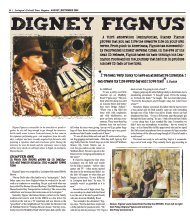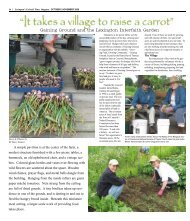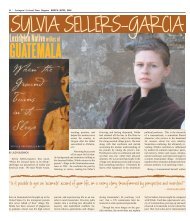Orchestrating Kids Through the Classics-Lexington Symphony's ...
Orchestrating Kids Through the Classics-Lexington Symphony's ...
Orchestrating Kids Through the Classics-Lexington Symphony's ...
Create successful ePaper yourself
Turn your PDF publications into a flip-book with our unique Google optimized e-Paper software.
24 | <strong>Lexington</strong>’s Colonial Times Magazine FEBRUARY | MARCH 2009<br />
A Third Grader’s Guide to <strong>the</strong><br />
Orchest r a<br />
Overview of Cary Hall filled with kids for <strong>Lexington</strong> Symphony 3rd grade program “<strong>Orchestrating</strong> <strong>Kids</strong> through <strong>Classics</strong>.” Photo courtesy of Fred Johnson.<br />
By Jane Whitehead<br />
Cary Hall, <strong>Lexington</strong>, January 14. This was a symphony concert with a difference: <strong>the</strong> young Mozart played a violin solo and<br />
Darth Vader made a guest appearance, menacing an audience of over 600 third-graders with his light saber, to <strong>the</strong> sound of John<br />
Williams’ stirring “Star Wars” <strong>the</strong>me.<br />
The hour-long concert, given by <strong>the</strong> 50-strong <strong>Lexington</strong><br />
Symphony Orchestra (LSO) under Music Director Jonathan<br />
McFee, was <strong>the</strong> centerpiece of “<strong>Orchestrating</strong> <strong>Kids</strong> <strong>Through</strong><br />
<strong>Classics</strong>.” LSO members and music teachers devised <strong>the</strong><br />
outreach effort to introduce every third grader in <strong>Lexington</strong><br />
public schools to <strong>the</strong> classical concert experience, and spark<br />
interest in <strong>the</strong> fourth and fifth-grade instrumental music<br />
program.<br />
Walter Pavasaris, Coordinator of Fine and Performing Arts<br />
for <strong>Lexington</strong> Public Schools, applauded LSO concertmaster<br />
Liz Whitfield for her self-effacing, passionate championship<br />
of <strong>the</strong> program, both as a musician and an administrator. “She<br />
was <strong>the</strong> catalyst that made this thing really work,” he said.<br />
The program received major funding from <strong>Lexington</strong><br />
Education Foundation (LEF), with additional support<br />
from Friends of <strong>Lexington</strong> Music, Art and Drama Students<br />
(FOLMADS) and Target. “People in <strong>the</strong> Symphony are<br />
really committed to <strong>the</strong> idea of outreach to kids in <strong>the</strong> whole<br />
surrounding community,” said former LEF Board member<br />
Cindy Lewis, who co-wrote <strong>the</strong> LEF grant application with<br />
LSO’s Rebecca Hawkins.<br />
The logistics were complex; in addition to mounting a<br />
full-scale concert, during <strong>the</strong> week beforehand, small groups<br />
of musicians visited every public elementary school in town to<br />
introduce <strong>the</strong>mselves, <strong>the</strong>ir instruments, and <strong>the</strong>ir music to <strong>the</strong><br />
entire third-grade.<br />
A Quartet in <strong>the</strong> Cafeteria<br />
On a January morning soon after <strong>the</strong> winter break, one<br />
hundred third graders from Bowman Elementary School<br />
sat on <strong>the</strong> floor of <strong>the</strong> cafeteria, eyes fixed on violinists Liz<br />
The monks sing<br />
plainchant to start<br />
off <strong>the</strong> program in<br />
<strong>the</strong> 1500’s. Photo<br />
courtesy of Fred<br />
Johnson.<br />
Diamond 6th grader Yuki Beppu, dressed as Mozart, performs Mozart’s Violin<br />
Concerto No. 4 with <strong>Lexington</strong> Symphony. Photo courtesy of <strong>the</strong> <strong>Lexington</strong> Symphony.<br />
Whitfield and Barbara Oren,<br />
tuba player Jobey Wilson and<br />
clarinetist Bill Kirkley.<br />
“We’ve never had<br />
anything like this before, and<br />
I’m thrilled,” said Bowman<br />
music teacher Martha Rogers,<br />
introducing <strong>the</strong> quartet.<br />
“Raise your hand if you’ve<br />
seen a symphony orchestra<br />
before,” said Rogers, and at<br />
least 50 hands shot up. The<br />
group played <strong>the</strong> opening of<br />
John Williams’ <strong>the</strong>me from <strong>the</strong> “Harry Potter” movies, to<br />
universal recognition. “That’s an example of where we often<br />
get to hear symphony orchestra music,” said Kirkley.<br />
Concertmaster Liz Whitfield told <strong>the</strong> group that her<br />
250-year old violin is “held toge<strong>the</strong>r with animal glue and<br />
<strong>the</strong> strings used to be made of sheep intestines,” to a chorus<br />
of “Gross!” and “Yuck!” She showed off <strong>the</strong> instrument’s<br />
versatility, playing a melody from Dvorak’s “New World”<br />
Symphony, plucking <strong>the</strong> strings, and playing over <strong>the</strong> bridge to<br />
make a shivery, “scary sound.” To demystify one of <strong>the</strong> rituals<br />
of <strong>the</strong> symphony concert, she showed how, before <strong>the</strong> start of<br />
<strong>the</strong> program, she would turn her back on <strong>the</strong> audience and give<br />
<strong>the</strong> signal for <strong>the</strong> orchestra to begin tuning.<br />
“Who can tell me what this large piece of plumbing<br />
in my hands is?” asked Jobey Wilson, hoisting his tuba.<br />
“Saxophone?” someone suggested. “We are <strong>the</strong> lowest playing<br />
of all <strong>the</strong> brass instruments,” he said, blowing a basso fart on<br />
<strong>Orchestrating</strong> <strong>Kids</strong><br />
<strong>Through</strong> <strong>Classics</strong><br />
<strong>the</strong> instrument, to laughter. After taking out<br />
<strong>the</strong> mouthpiece and showing how he makes<br />
<strong>the</strong> sound by “lip buzzing,” Wilson played<br />
part of <strong>the</strong> “Jaws” <strong>the</strong>me.<br />
Kirkley held up a couple of different sized<br />
recorders, “<strong>the</strong> ancestor of all our woodwind<br />
instruments,” and showed <strong>the</strong> difference<br />
between <strong>the</strong>m and his modern clarinet, with<br />
its “bunch of silver levers.” He played a few<br />
Gershwin-inspired slides and wails to show<br />
that woodwinds “make some of <strong>the</strong> sillier<br />
sounds in <strong>the</strong> orchestra.”<br />
“The kids are so excited,” said Rogers,<br />
at <strong>the</strong> end of <strong>the</strong> session. “It’s <strong>the</strong> perfect age<br />
to do this – <strong>the</strong>y’re just about to start playing<br />
recorder.” What’s important about <strong>the</strong>se<br />
previews, said violinist Barbara Oren, is<br />
that <strong>the</strong>y bridge <strong>the</strong> gap between <strong>the</strong> players<br />
and <strong>the</strong> audience. “You’re<br />
regular people sharing what<br />
you’ve learned and love<br />
about your instrument,”<br />
she said, “so <strong>the</strong>y’ll already<br />
have a connection when<br />
<strong>the</strong>y see you on stage.”<br />
Vader Invades<br />
At 9.30 in <strong>the</strong> morning<br />
on January 14, <strong>the</strong> entire<br />
LSO, in full concert dress<br />
(black for <strong>the</strong> women,<br />
tuxedos for <strong>the</strong> men) is on<br />
stage at Cary Hall. Over<br />
six hundred third graders<br />
Continued on page 27<br />
Above and left: Liz Whitfield demonstrates her violin.<br />
Below L to R: Barbara Oren, violin, Bill Kirkley,<br />
clarinet, Jobey Wilson, tuba, and Liz Whitfield,<br />
concertmaster, give an up-close demo of <strong>the</strong>ir<br />
instruments to prepare <strong>the</strong> 3rd graders from Fiske<br />
and Bowman Schools for <strong>the</strong> full orchestra concert a<br />
week later. Photos courtesy of Diane Sperandio.
Continued from page 11<br />
from <strong>Lexington</strong> and Arlington sit in expectant silence as <strong>the</strong><br />
orchestra tunes, <strong>the</strong>n Maestro Jonathan McFee bounds onstage<br />
to conduct <strong>the</strong> opening of <strong>the</strong> “Star Wars” <strong>the</strong>me, and a wave<br />
of excited recognition spreads through <strong>the</strong> audience. But after a<br />
few bars, <strong>the</strong> music abruptly stops, and all <strong>the</strong> musicians leave<br />
<strong>the</strong> stage.<br />
McFee – a winner of <strong>the</strong> Gabriel Award for his work on<br />
WCRB’s “Kid’s Classical Hour” – explains that <strong>the</strong> earliest<br />
music in <strong>the</strong> Western tradition was for voices, ra<strong>the</strong>r than<br />
instruments. “I think I see some monks,” he says, and dead<br />
on cue, four brown-robed singers process through <strong>the</strong> hall,<br />
intoning a medieval Gregorian plainsong chant.<br />
Moving at a brisk clip – “We’re doing <strong>the</strong> history of<br />
western music in one hour” – McFee introduces a band of<br />
“traveling minstrels” from <strong>the</strong> Renaissance, with recorders and<br />
drum, <strong>the</strong>n adds oboes, trumpets and stringed instruments for<br />
a performance of part of Johann Sebastian Bach’s Brandenburg<br />
Concerto Number 3, from <strong>the</strong> early eighteenth century.<br />
The stage fills with new instruments; bassoons, flutes and<br />
French horns, and McFee conducts a section of Joseph Haydn’s<br />
“Surprise” Symphony, Number 94. “Haydn had a good sense<br />
of humor,” he says. “Listen for <strong>the</strong> surprise.” There’s some<br />
laughter at <strong>the</strong> sudden loud chord that disrupts <strong>the</strong> music’s<br />
sedate progress.<br />
But perhaps <strong>the</strong> biggest surprise of <strong>the</strong> morning is <strong>the</strong><br />
performance of guest violin soloist and Diamond sixth-grader<br />
Yuki Beppu, 11, who comes onstage in knee-breeches and white<br />
powdered wig to play part of Mozart’s Violin Concerto No. 4<br />
in D major. With <strong>the</strong> first stroke of her bow Beppu transforms<br />
from schoolgirl into accomplished musician. McFee later<br />
describes how he first heard Beppu play at <strong>the</strong> New England<br />
Conservatory, where she studies in <strong>the</strong> Preparatory school and<br />
plays in <strong>the</strong> Trio Con Brio (with pianist Daniel Kim, a student<br />
at Clarke Middle School.) “I was just bowled over by her. Such<br />
confidence, such control, such musicianship,” says McFee.<br />
After Beppo’s bravura display, McFee introduces<br />
Beethoven (via a cell-phone ringtone rip-off of <strong>the</strong> opening notes<br />
of <strong>the</strong> Fifth Symphony), Tchaikovsky, and finally, Stravinsky.<br />
“Stravinsky told stories that people had never heard,” says<br />
McFee, describing <strong>the</strong> tumultuous first US performance of “The<br />
Rite of Spring,” in 1924, during which most of <strong>the</strong> audience left.<br />
The Cary Hall audience is getting a little wiggly itself, until, with<br />
<strong>the</strong> full firepower of <strong>the</strong> modern orchestra assembled on stage,<br />
McFee launches once more into “Star Wars,” this time blaring<br />
triumphantly through to <strong>the</strong> end. Darth Vader appears, blackcloaked,<br />
brandishing his light saber, and half <strong>the</strong> audience begins<br />
to conduct.<br />
Coda<br />
“I loved that – it was better than <strong>the</strong> movie!” one third-grade<br />
boy told McFee after <strong>the</strong> concert, underscoring <strong>the</strong> organizers’<br />
savvy choice of film music as a bridge between classical music<br />
FEBRUARY | MARCH 2 <strong>Lexington</strong>’s Colonial Times Magazine | 27<br />
<strong>Orchestrating</strong> <strong>Kids</strong> <strong>Through</strong> <strong>Classics</strong>...<br />
[It's] “a real magical synergy<br />
that’s now happening between<br />
(LSO) board members, players and<br />
<strong>the</strong> town.” Conductor,<br />
Jonathan McPhee<br />
and <strong>the</strong> young audience. “So many young people have really<br />
no contact – <strong>the</strong>y think – with a classical orchestra,” said<br />
McFee, but thanks to <strong>the</strong> work of musicians like Williams,<br />
<strong>the</strong>y are familiar with <strong>the</strong> symphonic sound. The next step,<br />
said McFee, is to feed <strong>the</strong>ir curiosity about how <strong>the</strong> sounds<br />
are made.<br />
Yuki Beppu accepted bouquets and congratulations,<br />
and explained that she practices two or three hours a day.<br />
“I don’t want to push <strong>the</strong> practice,” said her mo<strong>the</strong>r, Yuko,<br />
a medical researcher at Massachusetts General Hospital.<br />
Boston Philharmonic Orchestra conductor Benjamin Zander<br />
gave her some good advice, said Yuko Beppu, when <strong>the</strong>y met<br />
at a master class he was teaching a couple of years ago at<br />
NEC. “He told me, your job is to keep Yuki’s eyes shining,”<br />
she said. Leave <strong>the</strong> music, said Zander, to Yuki and her<br />
teachers, BSO violist Kazuko Matsusaka and former BSO<br />
concertmaster Joseph Silverstein.<br />
“ I couldn’t be more thrilled that <strong>the</strong> children are being<br />
exposed to such exceptional music - this is <strong>the</strong> perfect<br />
introduction,” said Ami Stix, ACT (Arts Created Toge<strong>the</strong>r)<br />
Coordinator for Bridge School. Her nine-year-old son had<br />
been “going round imitating <strong>the</strong> tuba” ever since <strong>the</strong> preview<br />
session at Bridge, she said.<br />
Students sent<br />
thank-you notes<br />
to <strong>the</strong> <strong>Lexington</strong><br />
Symphony and<br />
many students<br />
expressed <strong>the</strong>ir<br />
appreciation<br />
with artwork.<br />
Courtesy of<br />
<strong>the</strong> <strong>Lexington</strong><br />
Symphony.<br />
O<strong>the</strong>r third graders were equally enthusiastic. “It was<br />
<strong>the</strong> best music I ever heard,” wrote Nathaniel Keyes, from<br />
Fiske, in a classroom follow-up session after <strong>the</strong> concert.<br />
“My feelings were flowing with <strong>the</strong> music. It was like Cary<br />
Hall’s stage was sparkling,” wrote Bowman’s Alia Rizvi,<br />
while Evan Fang of Harrington said: “I might be a lot more<br />
interested in playing my piano and my recorder more often.”<br />
The whole program, said McFee, shows “a real magical<br />
synergy that’s now happening between (LSO) board<br />
members, players and <strong>the</strong> town.” That collaboration, said<br />
Walter Pavasaris, has led to “a wonderful opportunity for<br />
students to be able to hear a high-caliber orchestra,” and to<br />
learn from experience that “music can be made by people of<br />
all ages and from all walks of life.” That is a lesson that will<br />
last long after third grade is over.<br />
“It’s all about staying connected.


